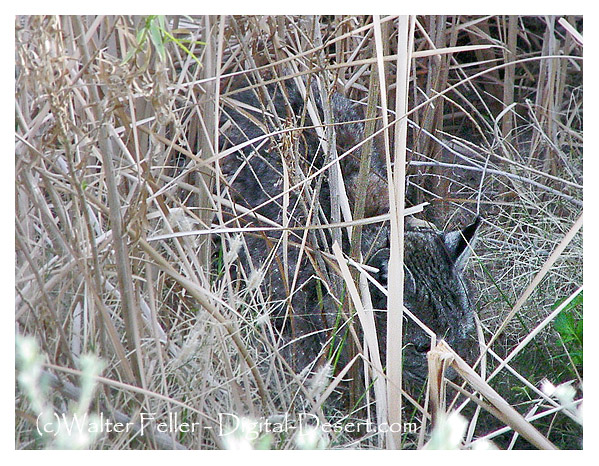Bobcat
Lynx rufusFamily: Felidae Order: Carnivora Class: Mammalia

DISTRIBUTION, ABUNDANCE, AND SEASONALITY
Common to uncommon, permanent resident throughout most of California. Use nearly all
habitats and successional stages. Optimal habitats are brushy stages of low and
mid-elevation conifer, oak,
riparian,
and
pinyon-juniper forests,
and all stages of chaparral.
SPECIFIC HABITAT REQUIREMENTS
Feeding: Bobcats largely are carnivorous. They eat various lagomorphs, rodents, a few
deer
(mostly young fawns), and some
birds,
reptiles,
amphibians, and invertebrates. They
also may consume substantial amounts of vegetation, mostly fruits and some grass (Provost
et al. 1973, Fritts and Sealander 1978b). These cats stalk or ambush prey on the ground,
from trees, or atop logs or rocks. Usually pursue prey for only a few leaps or bounds. May
cache when prey abundant or too large to consume in 1 day.
Cover: Use cavities in rock areas, hollow logs, snags, stumps, and dense brush for cover.
Reproduction: Dens usually located in cavities in rock areas, in hollow logs, snags,
stumps, or in dense brush.
Water: No information on water needs found. Probably need to drink water regularly.
Pattern: Suitable habitats for bobcats consist of large areas of broken, rough, rocky terrain
supporting brushy deciduous and conifer forests or chaparral, adjacent to smaller areas of
riparian habitat
and stands of dense forest. Availability of water may limit bobcat distribution
in xeric regions.
SPECIES LIFE HISTORY
Activity Patterns: Active yearlong. Mostly nocturnal and crepuscular, some diurnal
activity.
Seasonal Movements/Migration: Non-migratory. Distances travelled in 24 hr ranged from
2.6 km (1.6 mi) for an adult female, to 4.8 km (3 mi) for adult males.
Home Range: Female home ranges usually overlap very little; those of males may overlap
those of other males or females (Bailey 1974). In Riverside Co., Zezulak and Schwab (1980)
reported that home ranges of 7 bobcats varied from 4.7-53.6 km˛ (1.8-20.7 mi˛), with a mean
of 26.3 km˛ (10.3 mi˛). In Idaho, home ranges of females averaged 19.3 km˛ (75 mi˛), and
varied from 9.1-45.3 km˛ (3.5-17.5 mi˛). Those of males averaged 42.1 km˛ (16.3 mi˛), and
varied from 6.5-107.9 km˛ (2.5-41.7 mi˛) (Bailey 1974).
Territory: Scent marking appears to reduce actual contact, and fighting is very unusual. In
Idaho, territory and home range probably coincide (Bailey 1974,1981). In northeastern
California, Zezulak (1981) reported that home ranges overlapped up to 30% among females,
but there was almost no overlap among males. In southern California, Lembeck (1978) noted
almost no overlap of female home ranges, and up to 89% overlap among males. Zezulak and
Schwab (1980) reported results intermediate to Zezulak (1981) and Lembeck (1978).
Zezulak and Schwab (1980) speculated that bobcats may be territorial in some situations, but
not all. This flexibility in behavior results in higher population levels where they are not
territorial.
Reproduction: Bobcats usually breed in winter (Young 1958, Gashwiler et al. 1961).
Gestation period 60-70 days; most young probably born in spring in California. Litter size
averaged 3.5 in Wyoming, 2.8 in Utah, and 2.5 in Arkansas; range = 1-7. One litter/yr.
Females polyestrous. Females breed in first yr; males in second yr. Lactation continues
about 60 days. Individuals may live 10-14 yr.
Niche:
Great horned owls
may kill young bobcats (Jackson 1961), and adults occasionally
are taken by
mountain lions
(Young 1958) and domestic dogs. Bobcats and
coyotes
may compete (Robinson 1961), and when coyote numbers are reduced by predator control,
bobcat numbers may increase (Nunley 1978).
Source:
CDFW California Wildlife Habitat Relationships. Accessed [N/A]
https://wildlife.ca.gov/Data/CWHR
Color ranges from gray-brown to reddish. Ear tufts are used to aid hearing. The
Bobcat gets its name from its "bobbed" tail. The short, powerful bobcat has
adapted to pounce from ambush on
birds,
rodents
and
rabbits.
Keen senses and immense patience, the shadows and
night darkness assist this otherwise bashful creature in its deadly
hunt for food. Litters consist of one to seven
kits born between April and May in a den of dry leaves in hollow logs, or the shelter of
rock ledges and fallen trees. Their lifespan is about 25 years.
Also see > Mammal: Predator: Carnivore: Nocturnal
|
The Desert Food Chain * Everything has its niche. Who eats what, and what eats who in the desert? Click here to find out what more. |